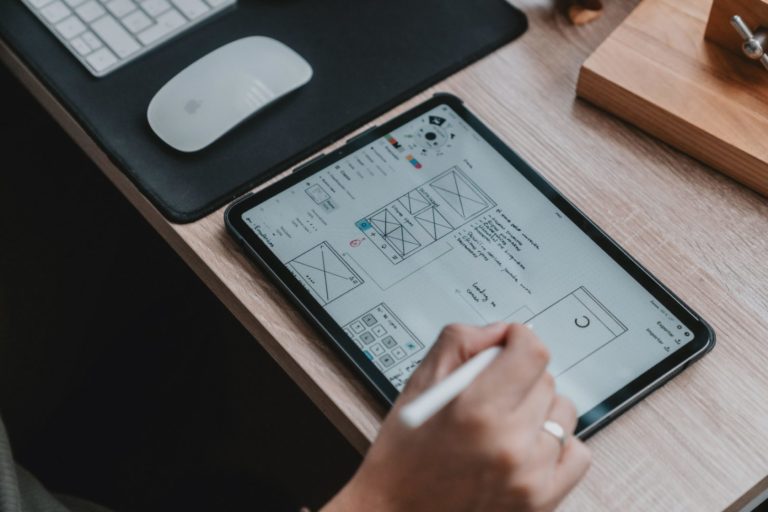As a business owner, understanding product lifecycle management is essential to your success! This guide will cover everything you need to know about PLM – from what it is and how the process works to the best tools to get the job done.
Defining PLM
Let’s start by defining PLM, or product lifecycle management. This term refers to the processes needed to manage the design, development, sales, and service of your products.
In other words, it’s how you go from an idea to a final product – and move it into the market. It requires you to have the right systems and solutions in place to manage data and tie these different segments together.
Product Lifecycle Management (PLM) is an overarching process and strategy that small businesses need to start using.
Ian Peterman, CEO Tweet
Similarly, you need to build processes around those platforms that help you leverage the skills of all the people and teams involved. When you do this right, you can speed up your time to market – and lower your overall cost of development.

Your goal for PLM should be to have a company-wide process that secures your product data and builds on it, to maximize efficiency and effectiveness at each stage of the product lifecycle.
Why is Product Lifecycle Management Important?

While you probably have a few ideas already, let’s dive into why product lifecycle management is so important.
For starters, PLM helps you address the issues that come up outside of the design and manufacturing stages. Product development and deployment don’t exist in a silo – and this process helps you integrate key resources and align efforts across your organization.
That means that product lifecycle management brings together your sales and marketing teams, customer service, and even your suppliers!
Here are some more reasons you need PLM:
Commercializing your Product
With the right PLM person or team, commercializing your product will be smoother and more efficient.
Ian Peterman, CEO Tweet
As you prepare to launch a product into the market, your workflows must be consistent across the company. PLM ensures that your data is effective and reliable, so your rollout can go smoothly.

For example, if your marketing team is looped in when a new product is designed, they will have an easier time sharing its value proposition.
Improving access to Data

Good PLM will produce more useful data to ensure the next product launch is better, and the current product can be managed well.
Ian Peterman, CEO Tweet
If you take anything away from how valuable PLM is, let it be this – it significantly improves your organization’s access to data. Product lifecycle management boosts efficiency by allowing every department to easily access the data they need.
Simply put, it creates a closed-loop environment that boasts data integrity and availability!
Integrating Manufacturing and Design
Another benefit of PLM is that it allows you to integrate product manufacturing and design. By optimizing your processes in real-time, you can eliminate bottlenecks and reduce the risk of miscommunication.
Understanding the Product Lifecycle Management Process
PLM can be defined a little differently depending on your company and product needs.
Ian Peterman, CEO Tweet
It’s not just important for business owners to be able to define PLM – you also need to have a thorough understanding of the process to implement it successfully.
So, how does product lifecycle management fit into other areas of operation, like development?

The key is that this process lets you bring your products to life by moving them through these stages:
Product Design
When you have an idea for a new product, the first thing you need to work on is the design. Here, PLM plays a vital role by allowing you to adapt the design as you test the product.
It allows you to manage design, simulation, and engineering simultaneously – so you can expedite this process. Any lost time during the design phase can eat into your profit margin – which means implementing PLM can boost your bottom line.
If your company engages in the engineer-to-order process, your customers need to be involved each step of the way. Product lifecycle management makes this easy and gives them a single solution for accessing design specs, product reviews, and sales data.
Production

Your PLM person or team should be part of your production planning and management.
Ian Peterman, CEO Tweet
Once you have a design locked in, you can move into production. PLM can not only speed this process up, but it can also reduce your overall production and development costs.
It can accomplish this by enhancing your ability to manage changes, expenses, and suppliers. With tools like version control and automatic workflow processing, you can track changes and adjust your production as needed.
Once you have a design locked in, you can move into production. PLM can not only speed this process up, but it can also reduce your overall production and development costs.
It can accomplish this by enhancing your ability to manage changes, expenses, and suppliers. With tools like version control and automatic workflow processing, you can track changes and adjust your production as needed.
Product Distribution and Service
Now that you have a final product, it is time to get it out into the market! To do this successfully, you need to ensure that all sales channels display the right product details. This will avoid errors with pricing, SKUs, and pricing attributes.
Product lifecycle management creates a single database for this data – so everyone from engineering to sales and marketing is using the right information. Remember that they need this data to distribute images, product manuals, and other essential content!
Note that the PLM process doesn’t end at distribution. It carries through to service, as customer satisfaction is essential for keeping your product relevant and preparing for the next version. As a result, PLM tools help you bring together quality processes and engineering.
PLM Tools
You may be wondering; what tools are used for product lifecycle management?
This software needs to be versatile since it must accomplish tasks at every stage of the product lifecycle. The right technology will integrate the following:
- CAD tools
- Computer-aided manufacturing
- Predictive analytics
- Finite element analysis
- Workflow processing
Although the systems can be diverse, they all specialize in consolidating platforms and allowing you to make real-time decisions at each stage. For instance, concurrent engineering workflow design lets you perform tasks in parallel – saving you valuable time and money
The Cost of Product Lifecycle Management
The cost of PLM and the software needed is not typically cheap, however it is an investment because it will save time, money, and help produce better products.
Ian Peterman, CEO Tweet
Although PLM systems can help you reduce costs, there will be expenses associated with setting up the platform and maintaining it.
If you choose to install the software locally, you will need to purchase it outright. This will require a significant investment upfront, and it will vary based on how many users and included features the system must support.

At a minimum, you can expect to spend about $80 per user – per month. That means if you have 50 users, your monthly cost will be about $4,000, which totals $48,000 annually.
Take caution when looking at advertisements for surprisingly low monthly fees, though. Instead, look for the tools that will help you improve your product design, development, and deployment processes.
What Provides the Best PLM?
Finding the right product lifecycle management depends on your needs, but there are a few things that all the best PLM systems do. This includes having robust change management features, quality control tools, strict version control, and analytics capabilities.
So, how do you narrow down the tons of options available on the market? Rather than spending hours on Google, try looking at Design Directory as a starting point.
Better yet, reach out to us at Peterman Design Firm. We can help you implement best practices in product lifecycle management and ensure you have a streamlined and effective process. Our goal is to get you the right PLM tools for your needs while staying within budget.
Contact us today to learn more!
Your Next Steps
Related Conscious Design BLOG Posts
3 Reasons you Should use a Firm and Not Just a Freelancer
A firm (like the Peterman Firm) can grow with you because it will have a team.
5 Tips to Creating Your Product Launch Plan
NASA isn’t the only place that should have a launch plan! After all of your time and money spent polishing your product the launch is a crucial step between your investment and your profits- NOT something you want to wing. It may feel like the end of a development process but it’s also the beginning of your next phase of business. At the Peterman Firm we support you through this stage, because creating a product launch plan can make or break a product in the market. We’ve seen many products flop because they didn’t have a plan at all. These are things you’ll need to be thinking of whether we help you or you launch on your own. Run the numbers When you have a final design that has been prototyped and you are looking to manufacture, you should be getting quotes from manufacturers for full production. Look at every cost you might have and give yourself an idea of what it is going to take to buy the first 100, 1,000, or even 10,000 units of your product. Knowing your numbers will help if you need to get financial help with the launching of your product. Have backup suppliers As any good developer or sourcing agent should tell you, you need backup suppliers. I’ve see production lines go down because a company didn’t get a backup supplier for a single bolt. Without the bolt, the product wasn’t made. Having primary, secondary, and even tertiary suppliers is important to make sure your products are made in time and you are able to deliver. We work with our clients to ensure multiple sources are provided for projects. Sourcing is a very important part of developing your product. Decide your launch platform This doesn’t just mean crowdfunding. Is your product going into large box stores, online marketplace, your own website, or some type of crowdfunding/launching platform? This can help decide what quantities you will be ordering in, and your marketing strategy. Are you going to use Amazon or another ecommerce site not run by you? If you are using a crowdfunding platform, there are definite differences and you need to research similar products and which is best for your industry and market. Set realistic goals It’s a good rule in general, but make sure that your goals are measurable and achievable. Especially while you are going through the process of launching an entire new product, keeping focus and having success happen is important. have a marketing strategy You need to know the who, where, and how of your marketing. There are lots of templates and website dedicated to discussing marketing. Who are you marketing to? It may be someone other than the user (such as baby toys). Where are you marketing? Online, radio, TV, billboards, etc. How are you marketing? Paying someone else, friends, or doing it all yourself? It doesn’t matter, just know what you are doing. BONUS: Keep your product launch plan flexible Don’t forget to create the actual plan! Just kidding, I’m sure you remember that. A quick note on plans, though. They never survive contact with the real world, so keep it flexible. Especially if you are a bootstrapping startup. Keep these things in mind as you create your product launch plan. This part of your project is something you want to start on as early as possible. As a last tip, make sure you have the right partnerships. They can bring you down or raise you up, and are largely outside of your direct control. As a full development firm instead of just a freelancer, we link our clients with the best possible partners for every stage of the process. Your Next Steps Struggling to create your own plan? Sign up for our free tutorial and learn about our course 4 Weeks to Launch + free tutorial Impressive Products Why Product Demos Must Go Beyond Impressions better product demos Related Conscious Design BLOG Posts Author Mr. Peterman View all posts
What is Design for Manufacturability?
Logically, you could figure out what Design for Manufacturability means in a broad sense. What does it really mean for you and your product? Design for Manufacturability, or DFM for short, is where Design meets Production. The DFM process takes a design and produces a final design that can be manufactured properly, and at the desired cost. This step is often skipped by those developing their first product. They end up costing more. Investing more on time and money than it should. We’ll go over some of what DFM does for your product and why it is a very key component to developing a great product. Manufacturability This is the first step in DFM. An engineer or designer takes a design and reviews it to ensure the product can be manufactured as efficiently and effectively as possible. Draft angles for injection molded parts, machinable areas for CNC, stacking tolerances, fit checks, and many more items are part of this DFM checklist. BLANK Ian Peterman, CEO Tweet Costing This is where things can get interesting, such as actually increasing part count, decreasing reusable parts, etc may be required to put a product into a certain price window. Costing looks at every cost of a product, from hardware selections, country of production, materials, and how each part needs to be made. A Sourcing Agent is closely tied into this part of the process, and works with the designer through this process. Part Count BLANK Ian Peterman, CEO Tweet How many parts does it take to make your product? I’ve worked on products ranging from just one to the thousands. A part count is a balancing act, sometimes you can make 4 parts into 1, but the cost would be 10 times greater. The part count is an easy way to estimate product complexity, assembly costs, et. Usually more is more expensive, and so a lot of work can be done to decrease the part count, make assembly easier, and take less time. Reuse and Replacement For those businesses who are sustainably minded, which every business should be, designing a product for reuse is something that happens in the DFM stage. Which components can be reused, which need to be replaced, even what parts can be recycled or not are also influence in the DFM process. Material and Finish blank Ian Peterman, CEO Tweet DFM also looks at what materials and finishes are used in a product. Sometimes a material might be chosen that doesn’t work well with a certain manufacturing process or is extra expensive. Changing a material, or finish can change the perceived quality, actual quality, and the cost of a product drastically. Lead time is also influenced by finishes as they add extra time to production. Lead Time A lead time of a product determines how quickly a business can turn its manufacturing investment into a profit. If it takes 10 weeks to produce a product, that means a business is going to wait at least 10 weeks before it gets paid. Decreasing lead time also falls within the DFM process. Shorter lead times mean quicker product turnaround, as well as usually less costly. Through selecting processes, materials, and finishes, the DFM process can save businesses from having long costly lead times on their products. Your Next Steps manufacturing Products Kickstarters and Manufacturing: What to Pay Attention to manufacturability Conscious Design Choosing a Manufacturer choose a manufacturer Related Conscious Design BLOG Posts Author Mr. Peterman View all posts


